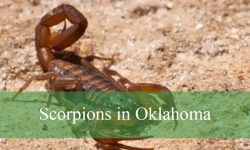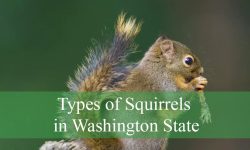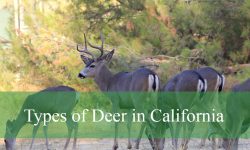The black bird with white belly is a beautiful sight among the trees. With its sleek black feathers contrasting sharply with its pristine white underside, it creates a striking silhouette against the green foliage. These birds, from woodpeckers to warblers, attract birders with their elegant appearance and melodious calls. Their presence adds contrast and beauty to the natural world, enriching our wilderness experience.
Join us to explore 33 species of black birds with white bellies in the list below to learn about their characteristics and how to identify them.
Different Types of Black Birds with White Bellies
Tufted Titmouse
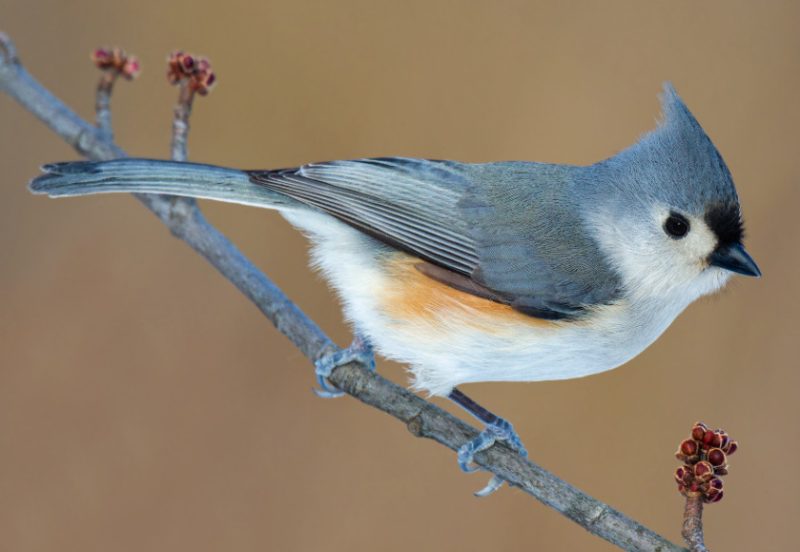
The tufted titmouse is similar to house sparrows in size, measuring 5.5-6.3 inches and with a wingspan of 7.9-10.2 inches, making it slightly larger than warblers. They are included here because of their white bellies, despite having grayish upperparts and white underparts with brownish sides.
Install bird feeders filled with sunflower seeds to draw them to your backyard. They form monogamous pairs and frequently roost together in the winter for warmth. They are known for their variety of vocalizations, which include whistles and chatters.
White-bellied drongo
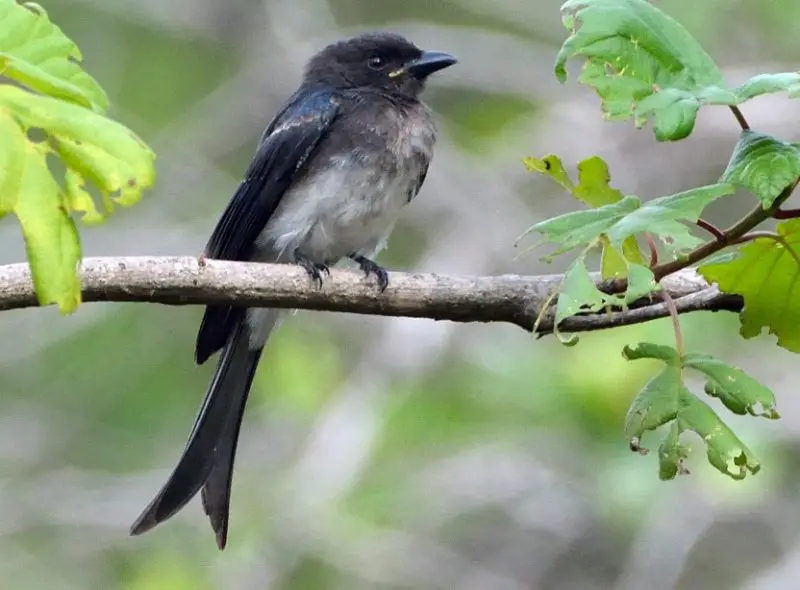
The Dicruridae family includes the white-bellied drongo, which is approximately 9.4 inches long. They are easily recognized by their distinctive dull-black back, forked tail, and short black bill. Generally speaking, females’ tails are longer than males’.
They live in open spaces close to human habitation as well as woods and woodlands throughout Southeast Asia. Using their agility in flying, they hover and then swiftly descend to capture insects. They may form small flocks despite usually being solitary or in pairs. They are noted for their variety of vocalizations, which include harsh cackles, whistles, and warbles.
White-bellied sea eagle

The white-bellied sea eagle is a powerful predator with enormous wingspan—its males can reach 26–31 inches and its females, 31–35 inches. Its weight is approximately 6.6 pounds. Their coloring is similar to that of titmice; they have white underparts and dark gray upperparts, as well as a characteristic black tail with white wing bars.
These raptors are opportunistic hunters found in Southeast Asian coastal locations. They consume a wide range of prey, such as fish, birds, mammals, and reptiles. They deposit about two eggs, which are incubated by both parents for about 45 days until the young eagles fledge at around six months old. They are distinguished by their enormous stick and branch nests, which they build in towering trees or cliffs close to water.
Blackpoll Warbler
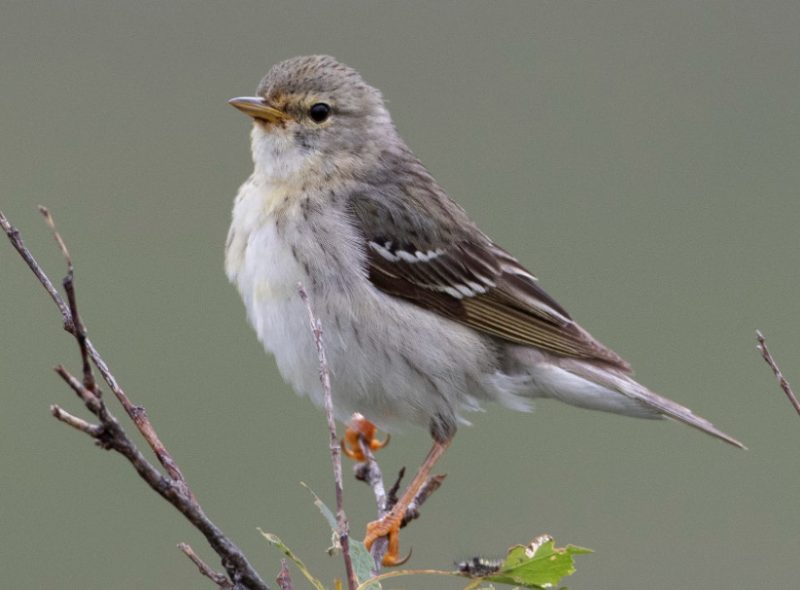
Similar to the black-throated gray warbler, the blackpoll warbler is around 0.5 oz in weight and has wingspan of 7.9 to 9.8 inches. Its measurements are 4.9–5.9 inches. It is easily recognized by its distinctive black crown, small bill, white cheeks, and black-white stripes. Males have brighter plumage, females have duller bodies with more heavily streaked bodies.
These birds migrate to Central and South America where they spend the winter. One of the longest known bird migrations occurs each fall when they migrate in large numbers across the Atlantic Ocean, demonstrating their incredible resilience.
White-breasted Nuthatch
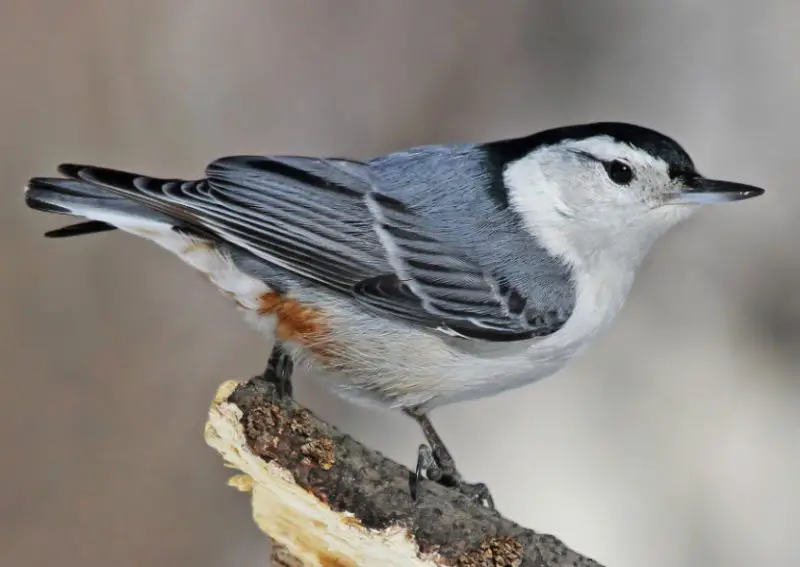
Measuring up to 6.1 inches in length, the white-breasted nuthatch is a tiny, neckless songbird native to North America, resembling an adult titmice. Its underparts have brownish patches, and its main plumage is gray with black highlights on the head and wing edges.
They live in trees and feed on the ground; they are common in forested places. As insectivores, they show off their amazing ability to hang upside down while feeding by using their long, pointed bills to retrieve insects from tree limbs and bark.
Black-billed Magpie
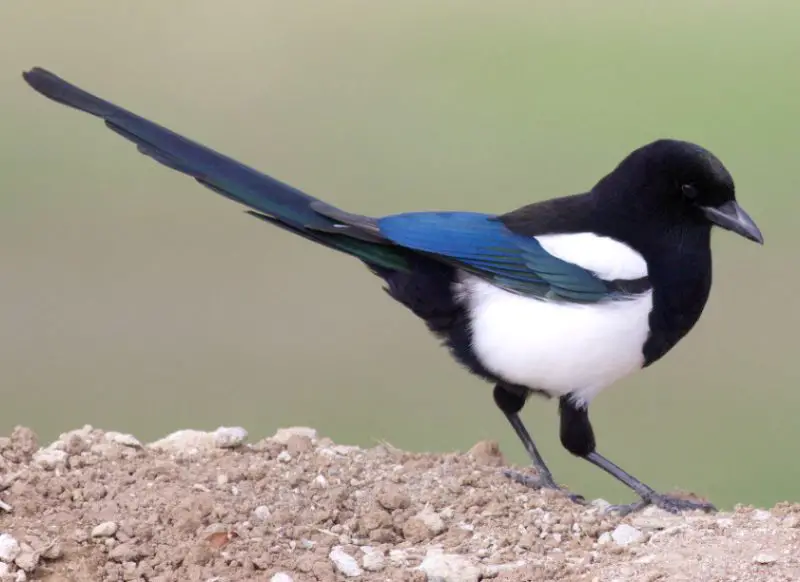
The black-billed magpie, often called the American magpie, has a length of 17.7–23.6 inches, a wingspan of 22.1–24 inches, and a maximum weight of 7.6 ounces. Its plumage includes a long tail, blue wings, white underparts, and a black back with a big, dark bill.
It belongs to the Corvidae family and is found in western North America. Populations have also been imported to East Asia. They eat fruit, rodents, insects, and carrion. They breed from March to July, when they live in pairs, and deposit clutches of 6-7 eggs that hatch in around 21 days.
White-bellied thicket fantail
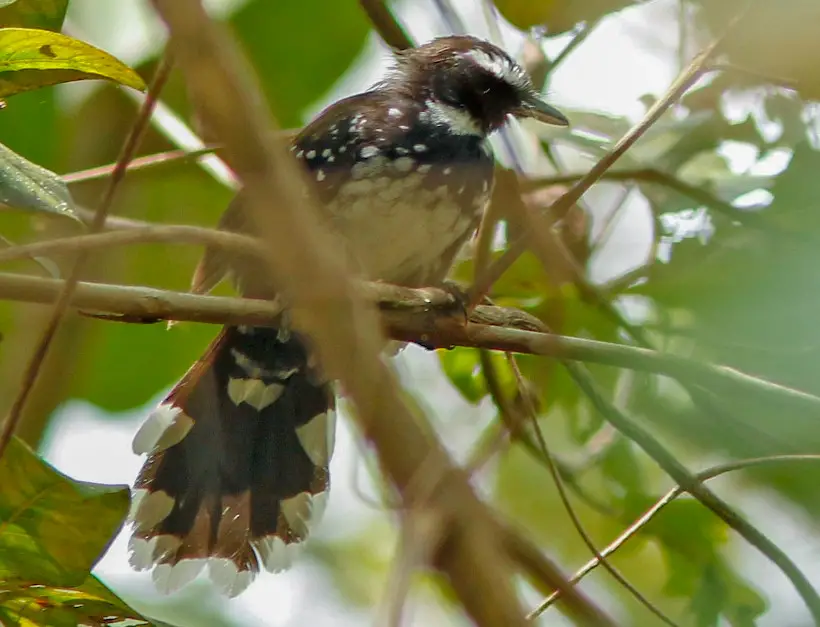
With a lengthy tail and a length of 7 inches, the white-bellied thicket fantail is an eye-catching bird that weighs around 0.7 oz. It is a bird of prey found in New Guinea that has black feathers with white spots on its chest, eyebrow, and abdomen. Its beautifully fan-shaped tail, which has a white tip, contributes to its name.
Mostly insectivorous, these secretive birds are elusive and prefer cover in forested thickets. Their high-pitched “joo-wii” calls enhance the forest’s enticing atmosphere.
White-bellied seedeater
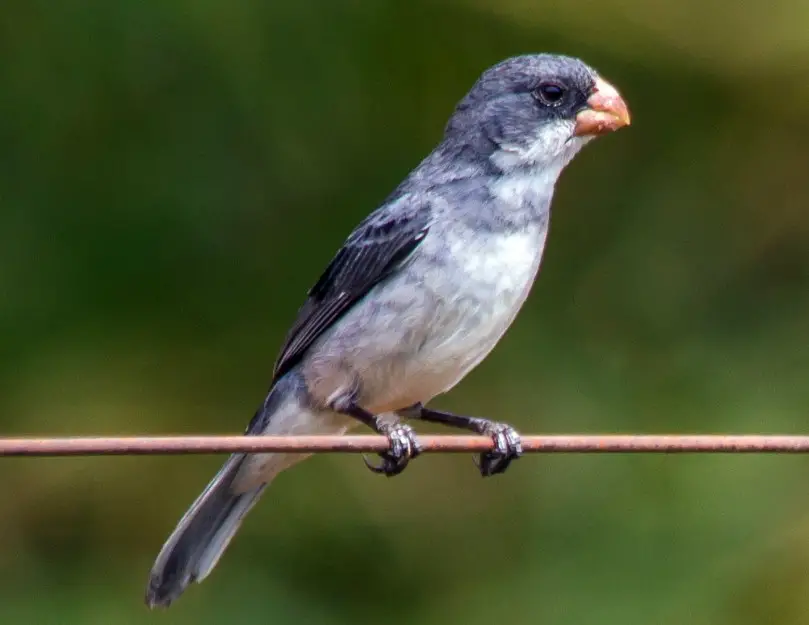
The white-bellied seedeater is a small tanager-family bird that is about 5 inches in length and weighs 0.6 oz in adult males. They can be recognized by their short, powerful bills and white bellies. Depending on the area, their backs can be either black or gray. Ladies have a bill that is black, brown wings, and a dull brown color.
They are found breeding in lowland moist forests, gallery forests, and other semi-open environments from Panama to northern Argentina and Trinidad. Their high, delicate notes, which they frequently sing while in flight, contribute to the atmosphere of their environment.
Eastern Towhee
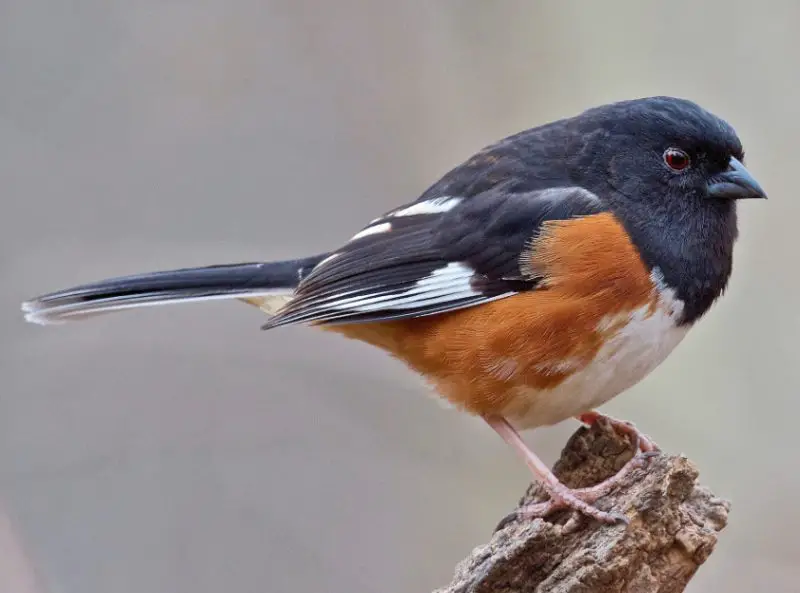
With a wingspan of 7.9–11.8 inches, the eastern towhee is a magnificent new world sparrow, measuring 6.8–9.1 inches. Its rufous sides, black upperparts, and white underparts are among its diverse color patterns. Males are distinguished by their long, black-and-white tail and prominent red eyes. The females have rufous sides and white underparts, with a brown upper body.
They are classified as ‘least concern’, indicating healthy populations, despite their covert nature. They are shy and favor deep vegetation; they search the ground for seeds and insects, sometimes consuming oranges or other fruit when it is available.
White-bellied treepie
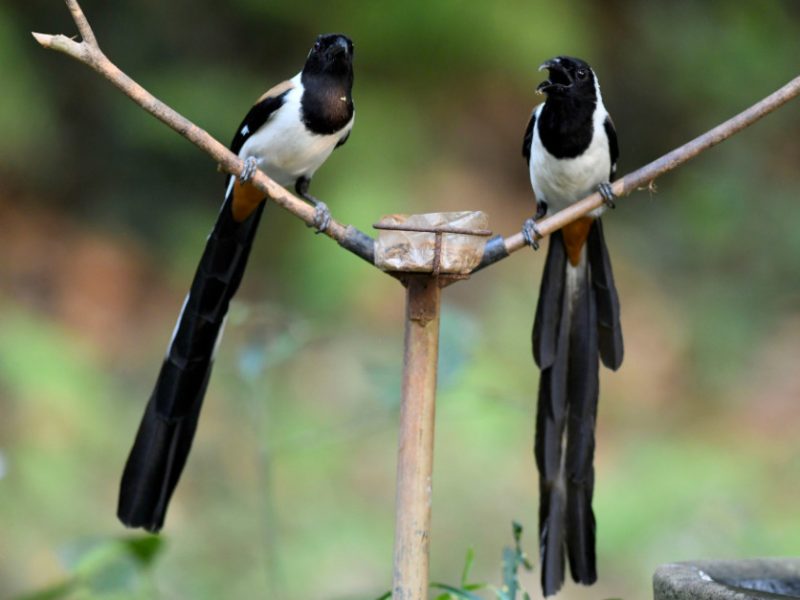
The white-bellied treepie is a magnificent bird of the Corvidae family that is about 19 inches long. Its tail adds to its remarkable look. They live in humid hill woods all across Asia and have black heads, wings, and tails with white spreading from the neck to the tail.
They eat fruit, reptiles, eggs, nestlings, and other birds. They can be identified by their harsh, grating, chattering, and hooting cries, which usually begin in April and continue until May, when nesting season begins.
Rose-breasted Grosbeak
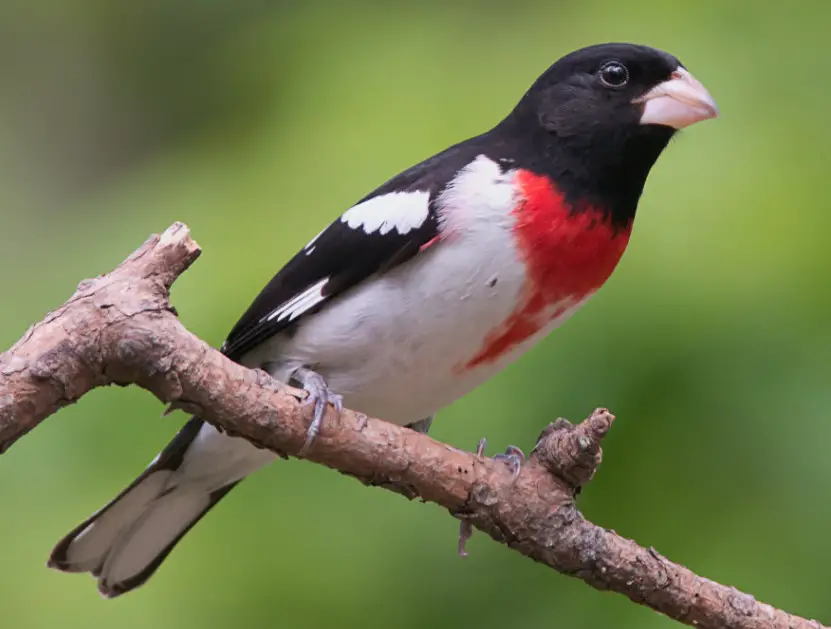
With an average length of 7.1–8.7 inches and a maximum weight of 2.3 oz, the adult rose-breasted grosbeak has an 11–13 inch wingspan. Males can be identified by their brilliant red breast, black head and back, and white patches on its wings. Females have brown plumage with extensive streaking, similar to purple finches, and a white eyebrow.
Across coniferous and deciduous forests, gardens, and parks, they can be found in North America. When confronted, they frequently hide in trees. Even though they are cautious birds, they have some of the loudest cries, such as chink and sharp squawks. Use backyard feeders with grape jelly to draw them in.
White-bellied woodpecker
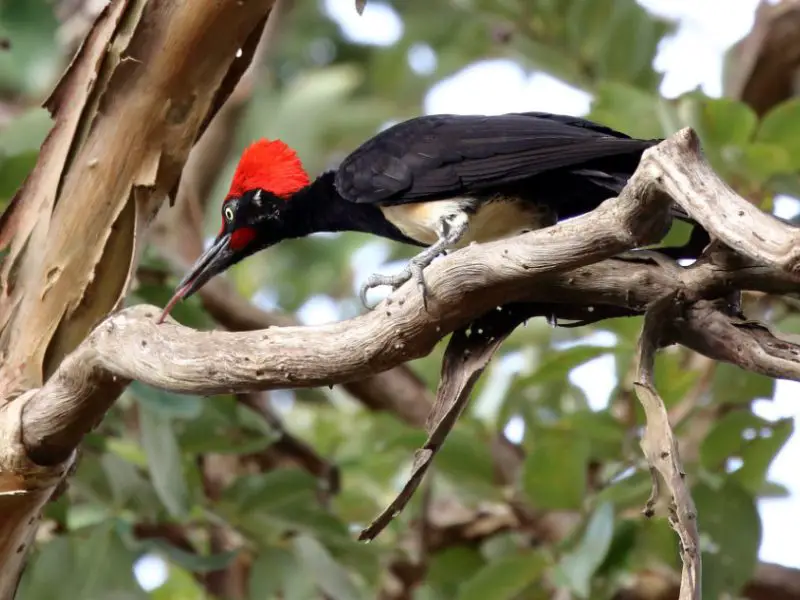
One of the largest woodpeckers is the white-bellied, which may reach lengths of 16 to 19 inches and weights up to 12.3 ounces. Both sexes have the same color pattern, with an all-black body with a white belly and crown and unique yellow eyes.
Throughout most of eastern Asia, they can be found in open or semi-open environments. They forage on the ground and eat insects that they extract from trees by pecking into the bark. They are renowned for their harsh “kyuk” and “kee-yow” sounds, and they usually lay four to six eggs in their tree cavities.
White-bellied minivet
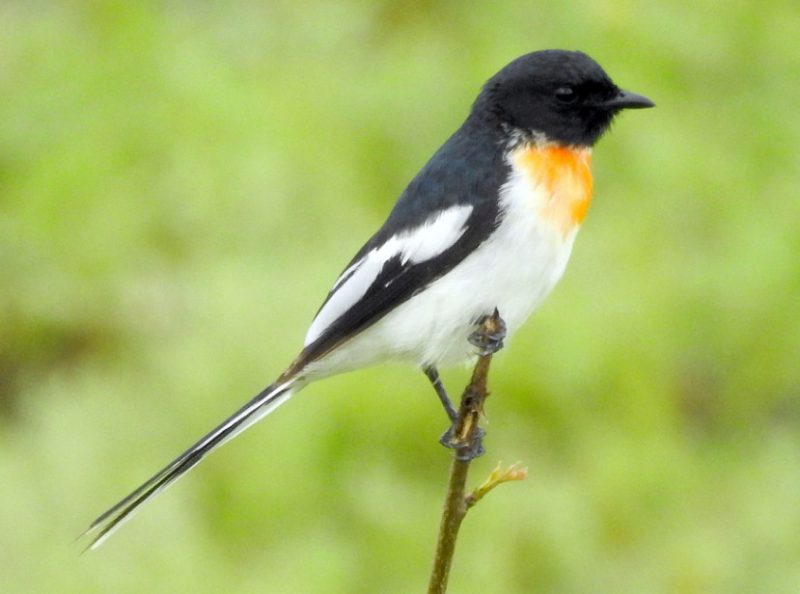
The white-bellied minivet is a medium-sized bird that ranges in size from 5.9 to 6.7 inches. Its heads and backs are completely black, and its white bellies and breasts have orange spots. Females are paler below and duller above.
They are mainly insectivorous and are members of the Campephagidae family of cuckooshrikes. They usually build their nests in trees using materials found in plants. The 2-4 eggs placed in the nest are incubated by both parents, demonstrating their cooperative breeding style.
Downy Woodpecker
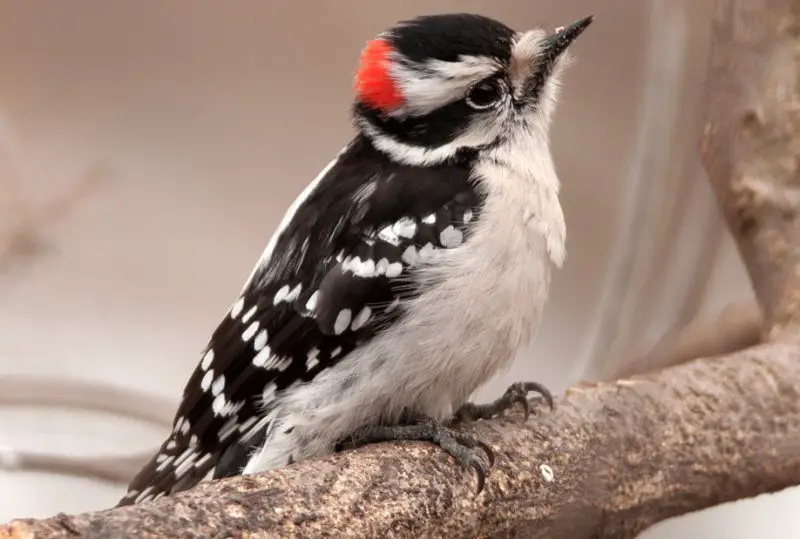
The tiniest woodpecker is the Downy Woodpecker, which is 5.5–7.1 inches long, 1.16 oz in weight, and has a wingspan of 9.8–12.2 inches. Males have red markings on the back of their heads, and females have white bellies and black and white plumage.
They are found in parks, woodlands, and yards. They mostly eat insects, such as spiders, beetles, ants, and caterpillars, with fruit and nuts as supplements. Three to eight 0.8-inch-long eggs make up their clutch, and they can spend up to three weeks nesting. After hatching, they are clumsy and need parental guidance to get through their early days.
White-bellied go-away-bird
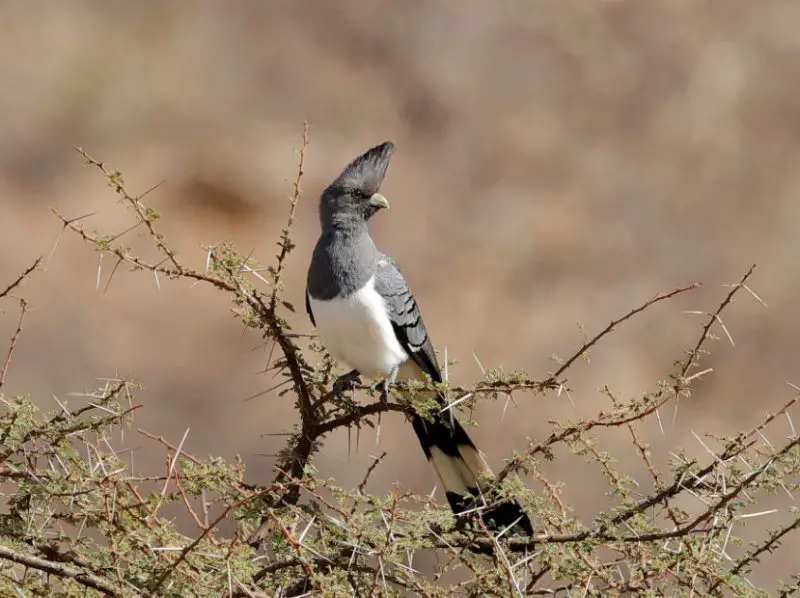
A member of the Turaco family, the white-bellied go-away bird is about 20 inches long. It has dark-grey and black plumage above and white below, a high crest, a long tail with a white band, and a small, curved bill. They live in open spaces such as grasslands and savannas in Africa. The name “going away” refers to the behavior of these birds when they feel threatened or disturbed.
They hunt on the ground and catch insects in the air, and their main food sources are plant materials and termites. Matriarchal, they form lifelong couples, the females building stick nests and laying two to five bluish eggs each.
Razorbill
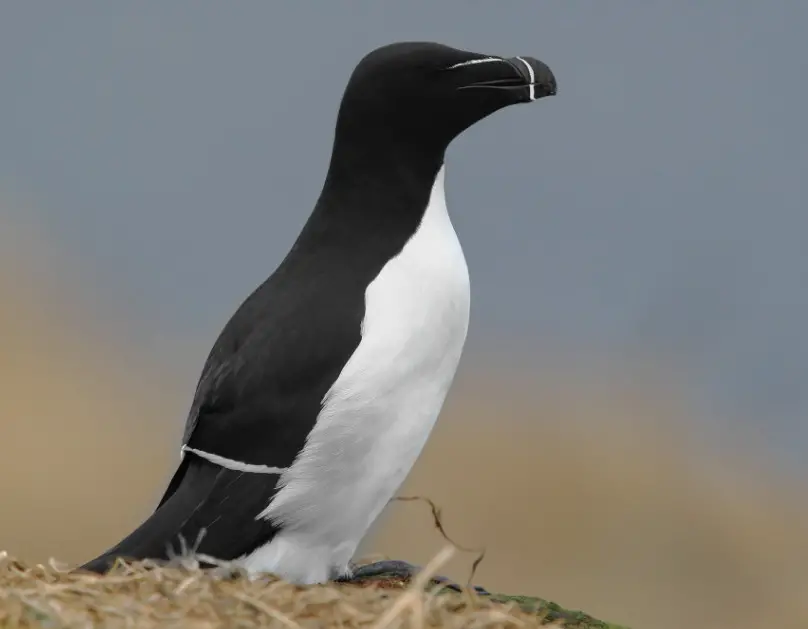
The striking black-and-white seabird known as the razorbill is about the size of an American crow, with a length of 16.9 inches, a wingspan of 24.8–26.8 inches, and a maximum weight of 31.4 oz. Their large blunt bill contrasts with the distinctive black and white hue of their plumage. They are mostly fish eaters, but they have also been observed to eat squid and crabs.
They have been reported to dive as low as 65 feet to find food. Its nesting colonies are usually found near the coast on cliffs, where they make their nasal growling cries. They have a special place in the biodiversity of birds because they are the only surviving member of the Alca family.
White-bellied goshawk
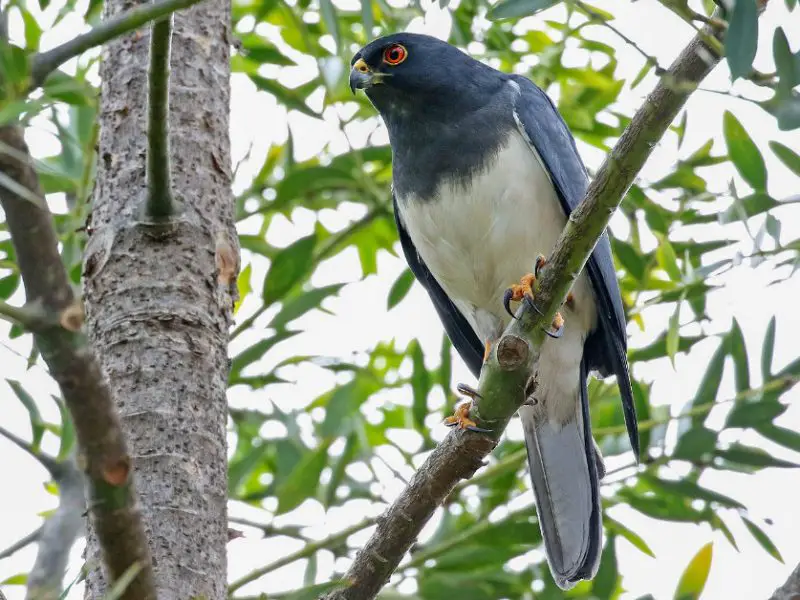
The New Caledonian sparrowhawk, or white-bellied goshawk, has a wingspan of 22.8–29 inches and measures 12.6–15.7 inches. Its stunning red eyes, golden feet, and beak with a black tip all draw attention to its dark grey-black plumage.
Primarily inhabiting trees, it feeds on small mammals, birds, and reptiles, with rare instances of ground hunting. Its lifelong pair ties, which are territorial and monogamous, influence its social behavior and the dynamics of its habitat.
Gentoo Penguin

One of the largest species, the Gentoo penguin, may grow to a height of 20 to 35 inches and weighs approximately 12 pounds (5.4 kg). They can be distinguished from other penguin species by their orange beaks and feet, as well as their white chests and tummies. They also have a long tail. They are well known for their exceptional swimming abilities, with a top speed of 22 mph.
They nest in colonies on rocky outcrops and beaches close to the water, and they breed from June to December. Black with a white belly at hatch, the chicks weigh about two pounds (0.9 kg). There are thought to be 26,000 breeding pairs remaining in the wild, making them vulnerable, according to the IUCN.
White-headed Woodpecker
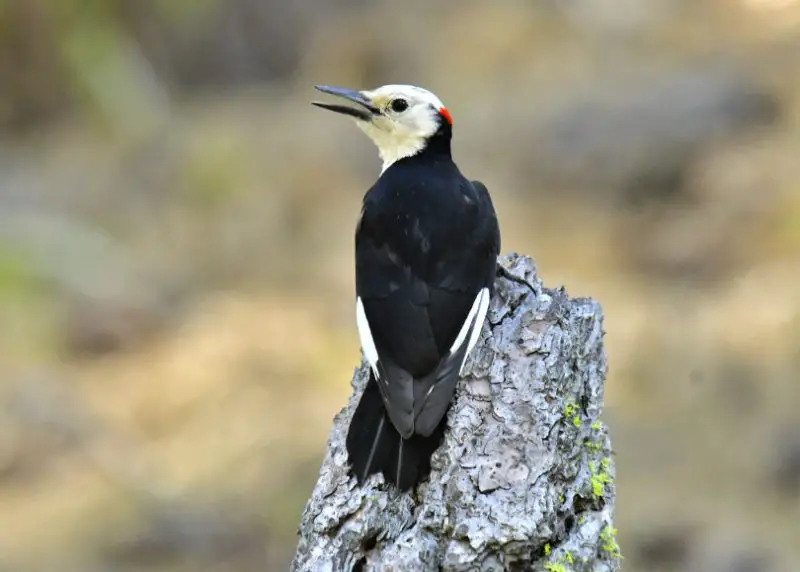
The white-headed woodpecker, which is recognized for its distinct “pee-kik” calls, is a medium-sized bird that ranges in size from 8.3 to 9.1 inches and weighs 1.9 to 2.3 ounces. Males have dark eyes and a tiny red crown, while females have predominantly black bodies and white heads.
They can be seen drilling into trees or logs from British Columbia to Southern California, where they mostly eat insects. They lay three to five eggs in their tree-hole nests.
Black-necked Stilt
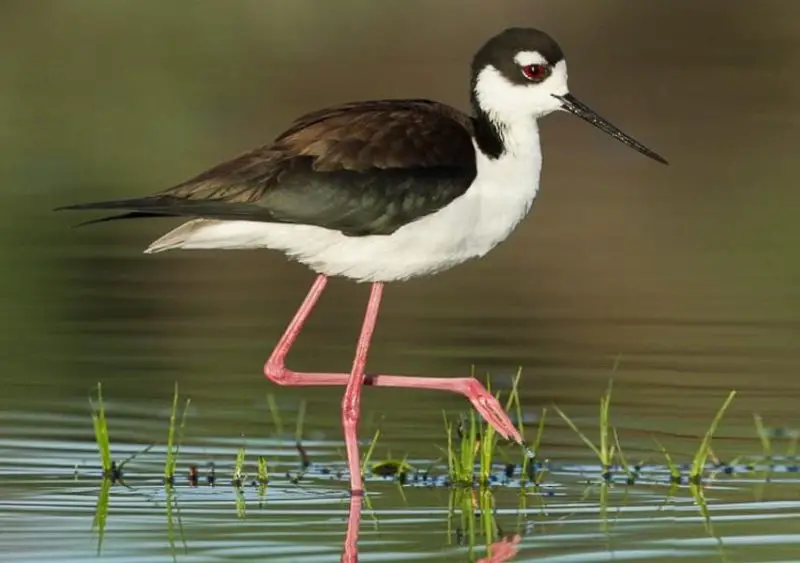
The black-necked stilt is distinguished by its long, sharp beak, red eyes and feet, and black and white plumage. Its dimensions are 13.8–15.3 inches by 28.1–29.7 inches in length and 5.3–6.2 oz in weight.
They are found in both North and South America, where they hunt insects, tiny fish, and crustaceans in bodies of water. Both parents incubate the two to five olive-speckled eggs that they lay in their ground nest near bodies of water. Before becoming independent, chicks spend up to eight weeks with their parents.
Black honeyeater
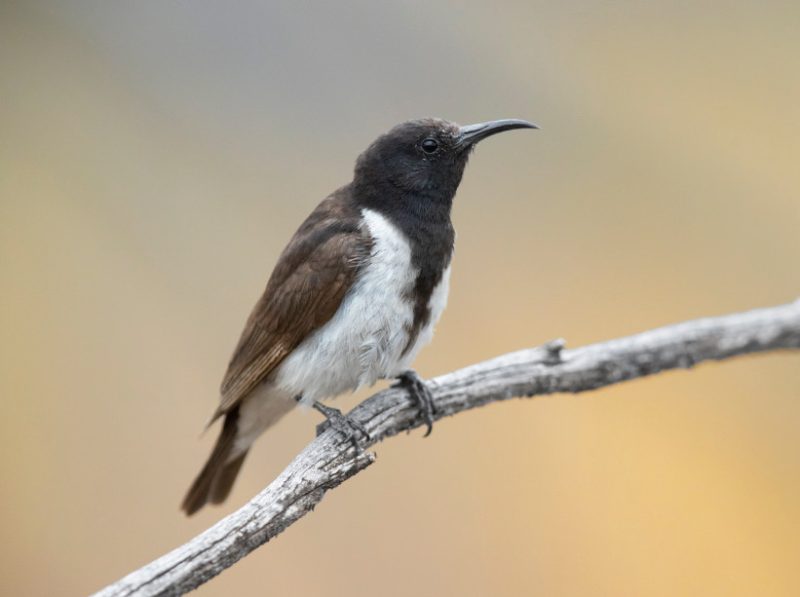
The black honeyeater, which is native to Australia, has a wingspan of around 7.5 inches and a length of 3.9–5.1 inches. Males are sexually dimorphic, with all-black uppers, white bellies, long, slender, curved bills, and dark eyes; females are whitish below and brown streaked above.
They are widespread throughout eastern and southern Australia, and among their many vocalizations is a high-pitched “chwit.” As insectivores, they search for insects among trees and construct cup-shaped nests out of bark and grasses in tree forks, where they lay clutches of two or three eggs.
Black skimmer
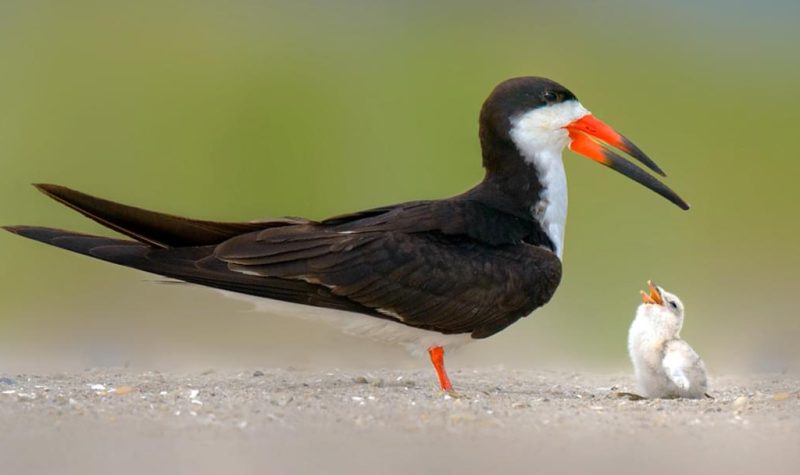
With a length of 15.8–19.7 inches and a wingspan of 42.9–45.3 inches, the black skimmer is distinguished by its black wings, long tail, white underbelly, black and red bill, and reddish–orange feet.
They are found all along the US coast, from California to Central and South America, and use their bills to skim the surface of the water in search of food. They make a variety of calls and move seasonally. They are vocal and migratory.
Black Phoebe
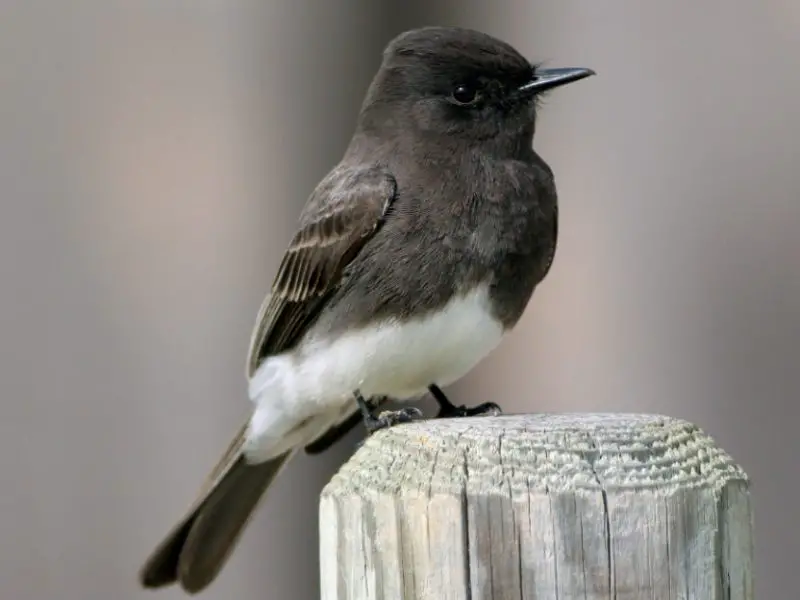
The black phoebe is a well-known bird that is slightly larger than dark-eyed juncos, measuring about 6.3 inches and weighing between 0.5 and 0.8 ounces. Its white belly contrasts with its black body. Its feathers are different in that adults have a dark upper body and white underparts, whereas juveniles have a browner upper body.
These little songbirds, which are distributed from California to Costa Rica, frequently congregate close to sources of water where they use them for nesting and foraging. Along rivers, streams, and lakes are typical places to see their nests, which are made of mud, sticks, and grasses. Because they eat a variety of insects, including dragonflies and mosquitoes, black phoebes are essential to the environment.
Eastern Kingbird
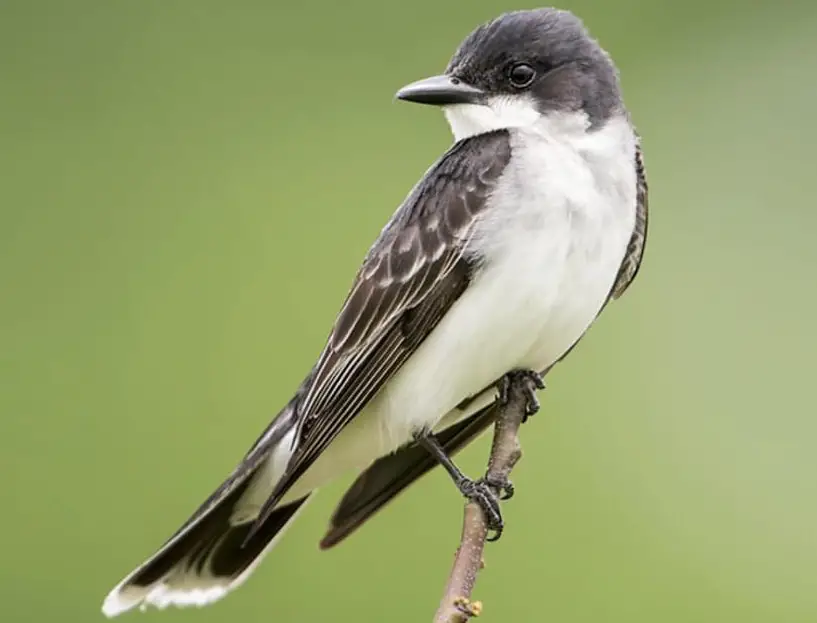
Medium-sized and gregarious, Eastern Kingbirds have a wingspan of 13–15 inches, a body length of 7.5–9.1 inches, and a maximum weight of 1.9 ounces. Their black upperparts and white bellies, tiny black bills, and dark eyes give them a resemblance to jays in stature.
The eastern United States is the primary breeding region for these migratory songbirds in North America. They mostly feed on insects, but they sometimes eat fruit, hovering or perching to capture their meal. Monogamous, they build their nests in trees or shrubs. The female lays three to five eggs, which hatch after 14 to 17 days, revealing naked, orange-skinned young.
White-bellied bush chat
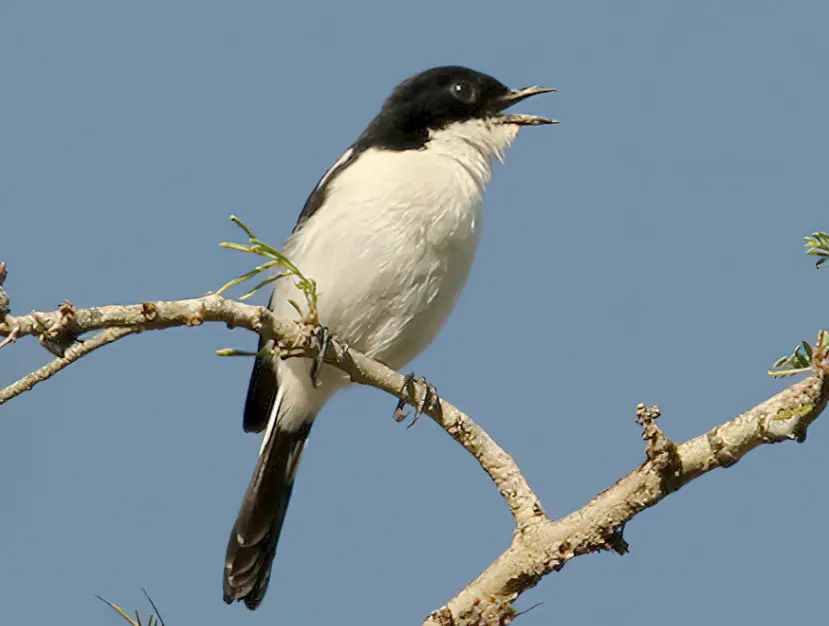
Measuring around 5.1 inches, the white-bellied bush chat is a member of the old world flycatcher family found in Southeast Asia. They have dark backs and heads with white undersides, resembling European robins and wheatears. They also have characteristic white wing patches and short bibs.
These birds, which thrive in moist lowland forests and arid savannas, have nearly flat bills that are perfect for collecting insects midflight. Their vocalizations, which contribute to the atmosphere of their environment, include distinctive “tchuk” and “cherrgrrr-wichu” noises.
Red-headed Woodpecker

As an adult, the red-headed woodpecker weighs 2 to 3.4 ounces and has a wingspan of 16.7 inches, making it a mid-sized bird. They have a black back, white wings, a red head, a whitish belly, and a robust beak that resembles a chisel. They live in wooded places in eastern North America and are mostly fed insects that are removed from tree bark.
They dig nesting cavities in tree trunks and engage in complex courtship rituals. They are monogamous and territorial, providing their young with intensive care. The IUCN has classified them as Least Concern because of their vast distribution and stable population.
Black-throated Gray Warbler
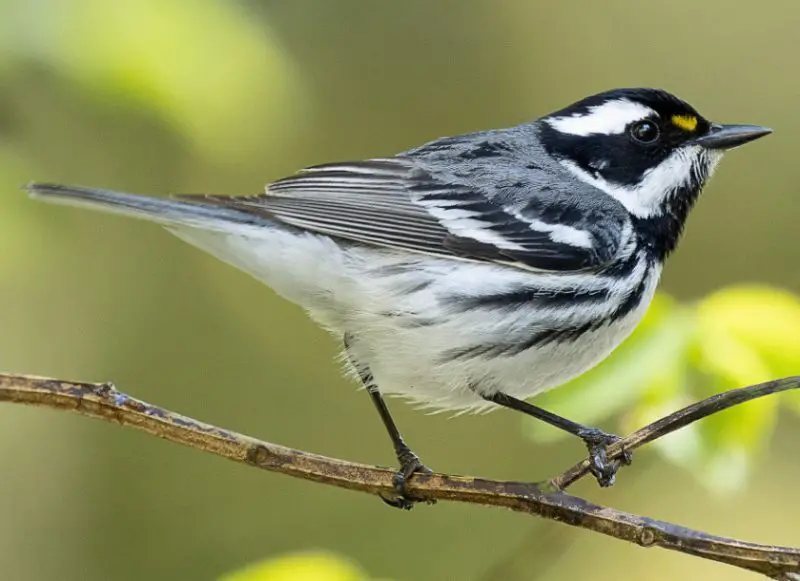
Found from California to British Columbia, the black-throated gray warbler is a unique white-bellied bird that is about 5.1 inches long, 0.3 ounces in weight, and has 2.2 to 2.7-inch wings. Both sexes have identical patterns, with the black throat with a little yellow spot in front of the eyes and black and white striped plumage that makes them easily identifiable.
Native to certain regions of western North America, these migratory songbirds breed in forests with conifers, the females depositing three to five speckled eggs there. They vocalize in the form of distinct high whistles, especially “zeedle-zeet-chee” sounds. They graze on the ground or at the base of trees, where they mostly eat insects. They also eat seeds and berries. They do not face extinction because they are thought to be common across their range.




